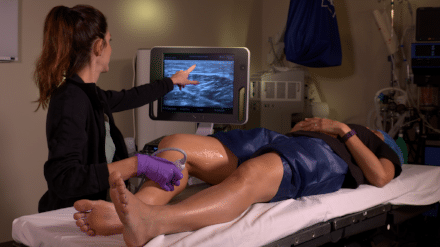Deep Vein Thrombosis Symptoms, Causes and Treatment
Risks of Deep Vein Thrombosis
Deep Vein Thrombosis (DVT) is a blood clot located within a deep vein, usually in the leg. A blood clot that breaks free and travels up to the heart or lungs is referred to as a Pulmonary Embolism (PE), which can stop blood flow and cause sudden death. The CDC estimates up to 100,000 Americans die every year from preventable DVT / PE.
In addition, Deep Vein Thrombosis blood clots in the leg can permanently damage veins. The result in 50% of DVT survivors is Chronic Venous Insufficiency which results in long-term leg pain, leg heaviness and leg swelling that can progress to difficulty in walking, changes in skin color and open leg sores (known as leg ulcers). Deep Venous Thrombosis can significantly impair quality of life.
Patient Testimonial
"I can't say enough good things about Dr. Jilanne Rose and her staff! Deciding to have a vein scan wasn't easy for me, but from the very moment they called me to set up my appointment, they made me feel at ease. Dr Rose was warm, knowledgable, and did NOT rush me through our appointment. She had lots of suggestions, and really made me feel like she was genuinely concerned about me - not just numbers or getting me in for procedures. Love this place and am very thankful that I reached out to them!"
S.F., Phoenix, Arizona
Advanced Vein Institute Patient
Symptoms of Deep Vein Thrombosis
Deep Venous Thrombosis symptoms include:
- Increased warmth in the affected area
- Pain or tenderness in the leg, ankle or foot
- Red or discolored skin
- Swelling in the affected area
Causes of Deep Vein Thrombosis
There are several factors known to contribute to the risk of DVT although a blood clot can occur in almost anyone, also known as DVT risk factors.
- Heredity (Genetics)
- Age
- Obesity
- Smoking
- Lack of Exercise
- Pregnancy or Recent Birth
- Recent Surgery or Hospitalization
- Cancer Treatments
- Prolonged Sitting (Airplane Travel)
- Extended Bed Rest
- Oral Contraceptives
- Hormone Replacement Therapy
- Alcohol Consumption
Treatment of Deep Vein Thrombosis
The absolute best way to diagnose Deep Venous Thrombosis is with a Full Vein Exam and Duplex Ultrasound. A vein clinic with an experienced vein specialist should be able to get you in the same day for diagnosis if you have any concern about blood clots in your legs. Treatment and prevention will be accomplished in several ways depending on the patient risk factors and severity but usually starts with blood thinning medication.
Prescription compression stockings are a common DVT preventative measure as are range of motion exercises, treating underlying blood disorders and vein therapy for Chronic Venous Insufficiency. An experienced vein doctor can discuss all treatment options with you after proper diagnosis following a full vein exam and duplex ultrasound.
Typically our vein center is available for same day DVT examinations. We understand the urgency of identifying Deep Vein Thrombosis and patients do not need to wait several hours in an emergency room to rule out DVT. If Deep Vein Thrombosis is identified, DVT treatment is initiated immediately with prescription medications and/or surgical intervention at our Mesa vein center location of Comprehensive Interventional Care Centers with Dr. Joel Rainwater.
Next Steps for DVT Evaluation
At Advanced Vein Institute of Arizona, we understand that DVT is a serious medical issue and should be tended to immediately. In addition, varicose veins should be fully diagnosed in order to rule out any larger, more complex issues like Chronic Venous Insufficiency (CVI) or Deep Vein Thrombosis (DVT). A full exam and duplex ultrasound will enable us to properly diagnose and recommend treatment based on the specifics of your situation.
Are you ready to get started?
Not quite sure yet?
Why not read what other patients have said, we love to share feedback!





